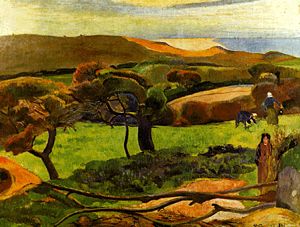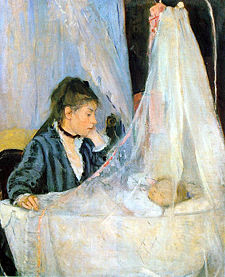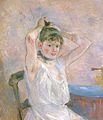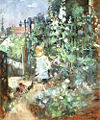Difference between revisions of "Berthe Morisot" - New World Encyclopedia
m |
|||
| Line 3: | Line 3: | ||
'''Berthe Morisot''' (January 14, 1841 – March 2, 1895) was a [[painter]] and a printmaker, and the first woman member of the circle of painters in [[Paris]] who became known as the [[Impressionists]]. She and American-born [[Mary Cassatt]] were the most famous women impressionist painters. They are considered by many to be the most important women painters of the later nineteenth century. | '''Berthe Morisot''' (January 14, 1841 – March 2, 1895) was a [[painter]] and a printmaker, and the first woman member of the circle of painters in [[Paris]] who became known as the [[Impressionists]]. She and American-born [[Mary Cassatt]] were the most famous women impressionist painters. They are considered by many to be the most important women painters of the later nineteenth century. | ||
| − | Painting ran in Morisot's family, and she enjoyed success in her early exhibits at the exteemed [[Paris Salon|Salon de Paris]]. However, she withdrew from the Salon in solidarity with her fellow artists whom official critics had rejected as engaging in "mere impressionism," a title she and her circle came to embrace as describing their desire to convey the visual impressions | + | Painting ran in Morisot's family, and she enjoyed success in her early exhibits at the exteemed [[Paris Salon|Salon de Paris]]. However, she withdrew from the Salon in solidarity with her fellow artists whom official critics had rejected as engaging in "mere impressionism," a title she and her circle came to embrace as describing their desire to convey the visual impressions light playing on objects and color. She worked in close collaboration with [[Édouard Manet]], who painted a well known portrat of her (at right), influenced her style, and in turn was influenced by her to adopt the "high-keyed palate" and the [[plein air]] style of painting out or doors. Many of her works focused on family life, and is considered a master at the subtle use color and light. |
| − | |||
==Biography== | ==Biography== | ||
| Line 13: | Line 12: | ||
After dedicting herself to painting at an early age, she exhibited a seriousness that many women at the time were not able to achieve. By age 20, she met and befriended artist [[Camille Corot]], under whose tutelage see work from 1862 to 1868. | After dedicting herself to painting at an early age, she exhibited a seriousness that many women at the time were not able to achieve. By age 20, she met and befriended artist [[Camille Corot]], under whose tutelage see work from 1862 to 1868. | ||
| − | The older artist instructed Berthe and her sister in painting and introduced them to other artists and teachers. Under Corot's influence, Morisot took up the [[plein air]] method of working. | + | The older artist instructed Berthe and her sister in painting and introduced them to other artists and teachers. Under Corot's influence, Morisot took up the [[plein air]] method of working out of doors. As art students, Berthe and Edma worked closely together until Edma married, had children, and no longer had time to paint so intensely as Berthe. Letters between them show a loving and cordial relationship, underscored by Berthe's regret at the distance between them and about Edma's withdrawal from painting. Edma wholeheartedly supported Berthe's continued work and the families of the two sisters always remained close. |
| − | |||
| − | |||
| + | Morisot's first appearance at the influential [[Paris Salon|Salon de Paris]] came at the age of 23 in 1864, with the acceptance of two [[landscape]] paintings. She continued to exhibit regularly in the Salon, to generally favorable reviews, until 1873, the year before the first [[Impressionism|Impressionist]] exhibition there. However, official criticism and rejection of many impressionists caused Morisot with withdraw from the Salon in 1874, in solidarity with her fellow artists of that genre. In fact, the term "impressionist" was originally used as a derisive term, but the artists of this school embraced it. (Denvir, 2000, pp. 29-79) Today the Impressionists are both popular and well respected, with prints of their colorful paintings adorning countless homes. | ||
==Manet and impressionism== | ==Manet and impressionism== | ||
| − | [[Image:Berthe Morisot | + | [[Image:Berthe Morisot No jardim.jpg|thumb|left|300px|"No Jardim" by Berthe Morisot, ''plein air'' style.]] |
| − | |||
Meanwhile, in 1868, she became acquainted with [[Édouard Manet]]. He took a special interest in Morisot, as is evident from his warm portrayal of her in several paintings, including a striking portrait study of Morisot in a black veil, while in mourning for her father's death. (See image at top of this article.) Correspondence between them shows affection. He once gave her an [[easel]] as a [[Christmas]] present. He also interfered in one of her Salon submissions when he was engaged to transport it. Manet mistook one of Morisot's self-criticisms as an invitation to add his corrections, which he did, much to Morisot's dismay. | Meanwhile, in 1868, she became acquainted with [[Édouard Manet]]. He took a special interest in Morisot, as is evident from his warm portrayal of her in several paintings, including a striking portrait study of Morisot in a black veil, while in mourning for her father's death. (See image at top of this article.) Correspondence between them shows affection. He once gave her an [[easel]] as a [[Christmas]] present. He also interfered in one of her Salon submissions when he was engaged to transport it. Manet mistook one of Morisot's self-criticisms as an invitation to add his corrections, which he did, much to Morisot's dismay. | ||
| − | Although traditionally Manet has been | + | Although traditionally Manet has been characterized as the master and Morisot as the follower, there is evidence that their relationship was a reciprocating one. (Turner, 2000, p. 319.) Morisot had developed her own distinctive artistic style, and records show Manet's approval and appreciation of certain stylistic and compositional decisions that Morisot originated. He incorporated some of these characteristics into his own work. She encouraged him to adopt the impressionistic "high-keyed palate" and to abandon the use of black and grays. Her own compositions used bright-hued colors, free of the grays and blacks of contemporary painters. |
[[Image:Berthe Morisot, Le berceau (The Cradle), 1872.jpg|left|thumb|225px|''The Cradle'', by Berthe Morrisot, 1872, Musée d'Orsay]] | [[Image:Berthe Morisot, Le berceau (The Cradle), 1872.jpg|left|thumb|225px|''The Cradle'', by Berthe Morrisot, 1872, Musée d'Orsay]] | ||
| − | It was Morisot who convinced Manet to attempt [[plein air]] painting, which she had been practicing since having been introduced to it by Corot. She also drew Manet into the circle of painters who soon became known as the [[Impressionism|Impressionists]]. In 1874, Morisot married Manet's brother, Eugene, and they had one daughter, Julie. | + | It also was Morisot who convinced Manet to attempt [[plein air]] painting, which she had been practicing since having been introduced to it by Corot. She also drew Manet into the circle of painters who soon became known as the [[Impressionism|Impressionists]]. In 1874, Morisot married Manet's brother, Eugene, and they had one daughter, Julie. |
| − | As a doctrinaire Impressionist as well as a member of the ''haute bourgeoisie'', Morisot painted what she experienced on a daily basis. Her paintings reflect the ninteenth century cultural restrictions of her class and gender. She avoided urban and street scenes as well as the nude figure. Like her fellow female Impressionist, Mary Cassatt, she focused on domestic life and portraits in which she could use family and personal friends as models. Paintings like ''The Cradle'', 1872, in which she depicted current trends for nursery furniture, reflect her sensitivity to fashion and advertising, both of which would have been apparent to her female audience. | + | As a doctrinaire Impressionist as well as a member of the ''haute bourgeoisie'', Morisot painted what she experienced on a daily basis. Her paintings reflect the ninteenth century cultural restrictions of her class and gender. She avoided urban and street scenes as well as the nude figure. Like her fellow female Impressionist, [[Mary Cassatt]], she focused on domestic life and portraits in which she could use family and personal friends as models. Paintings like ''The Cradle'', 1872, in which she depicted current trends for nursery furniture, reflect her sensitivity to fashion and advertising, both of which would have been apparent to her female audience. |
==Morisot's Paintings== | ==Morisot's Paintings== | ||
Morisot's work was delicate and had a subtle use of color, never using black or grays in shadow but often exhibiting an emerald glow with specks and dabs of reflected light, producing an immediate sense of color caught in the flicker of light upon the surface of the subject matter but not focusing on the subject matter itself. | Morisot's work was delicate and had a subtle use of color, never using black or grays in shadow but often exhibiting an emerald glow with specks and dabs of reflected light, producing an immediate sense of color caught in the flicker of light upon the surface of the subject matter but not focusing on the subject matter itself. | ||
| − | + | [[Image:Berthe Morisot Kind zwischen Stockrosen.jpg|thumb|250px| ''Child among staked roses'', by Berthe Morrisot, 1881, [[Wallraf-Richartz Museum]][[Cologne]]]] | |
| + | [[Image:Berthe Morisot 002.jpg|thumb|250px]] | ||
Her works include not only landscapes, portraits, garden settings, and boating scenes, but also subjects portraying the comfort and intimacy of family and domestic life, as did her colleagues, [[Pierre-Auguste Renoir]] and [[Mary Cassatt]]. Though she was not successful commercially during her life time, she outsold [[Claude Monet]], [[Pierre-Auguste Renoir]], and [[Alfred Sisley]]. | Her works include not only landscapes, portraits, garden settings, and boating scenes, but also subjects portraying the comfort and intimacy of family and domestic life, as did her colleagues, [[Pierre-Auguste Renoir]] and [[Mary Cassatt]]. Though she was not successful commercially during her life time, she outsold [[Claude Monet]], [[Pierre-Auguste Renoir]], and [[Alfred Sisley]]. | ||
| Line 41: | Line 39: | ||
* [[Portrait of Edma Pontillion]], 1869, (Young Woman Seated at a Window), the artist's sister at a window. | * [[Portrait of Edma Pontillion]], 1869, (Young Woman Seated at a Window), the artist's sister at a window. | ||
* [[Marine]], 1869, (The Harbor at Larient), oil. | * [[Marine]], 1869, (The Harbor at Larient), oil. | ||
| − | |||
| − | |||
* [[La Lecture]], 1869-70, (Reading: The mother and sister, Edma, of the artist), oil. | * [[La Lecture]], 1869-70, (Reading: The mother and sister, Edma, of the artist), oil. | ||
| Line 65: | Line 61: | ||
<br clear="all" /> | <br clear="all" /> | ||
{{Commonscat|Berthe Morisot}} | {{Commonscat|Berthe Morisot}} | ||
| + | |||
| + | ===Gallery=== | ||
| + | <gallery> | ||
| + | Image:Berthe Morisot Jeune fille au bal.jpg|''Jeune fille au bal'' | ||
| + | Image:Berthe Morisot The Bath.jpg|''The Bath'' | ||
| + | Image:Berthe Morisot 001.jpg | ||
| + | Image:Berthe Morisot Winter aka Woman with a Muff.jpg | ||
| + | Image:Berthe Morisot Kind zwischen Stockrosen.jpg | ||
| + | Image:Berthe Morisot Caça de borboleta.jpg | ||
| + | Image:Berthe Morisot 003.jpg | ||
| + | Image:Berthe Morisot 004.jpg | ||
| + | Image:Berthe Morisot 005.jpg | ||
| + | Image:Berthe Morisot 006.jpg | ||
| + | Image:Berthe Morisot 007.jpg | ||
| + | </gallery> | ||
== See also == | == See also == | ||
* [[Women artists]] | * [[Women artists]] | ||
| − | |||
| − | |||
| − | |||
==References== | ==References== | ||
Revision as of 23:44, 8 April 2007
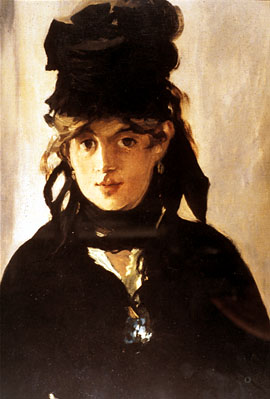
Berthe Morisot (January 14, 1841 – March 2, 1895) was a painter and a printmaker, and the first woman member of the circle of painters in Paris who became known as the Impressionists. She and American-born Mary Cassatt were the most famous women impressionist painters. They are considered by many to be the most important women painters of the later nineteenth century.
Painting ran in Morisot's family, and she enjoyed success in her early exhibits at the exteemed Salon de Paris. However, she withdrew from the Salon in solidarity with her fellow artists whom official critics had rejected as engaging in "mere impressionism," a title she and her circle came to embrace as describing their desire to convey the visual impressions light playing on objects and color. She worked in close collaboration with Édouard Manet, who painted a well known portrat of her (at right), influenced her style, and in turn was influenced by her to adopt the "high-keyed palate" and the plein air style of painting out or doors. Many of her works focused on family life, and is considered a master at the subtle use color and light.
Biography
Morisot was the granddaughter of the Rococo painter, Jean-Honoré Fragonard. He had been one of the most prolific Rococo painters of the ancien régime, whose handling of color and expressive, confident brushwork influenced later painters. Berthe was born in Bourges, Cher, France into a successful bourgeois family. Both she and her sister Edma Morisot chose to become painters, receiving instruction in drawing and painting. Once Berthe settled on pursuing art, her family did not impede her career.
After dedicting herself to painting at an early age, she exhibited a seriousness that many women at the time were not able to achieve. By age 20, she met and befriended artist Camille Corot, under whose tutelage see work from 1862 to 1868.
The older artist instructed Berthe and her sister in painting and introduced them to other artists and teachers. Under Corot's influence, Morisot took up the plein air method of working out of doors. As art students, Berthe and Edma worked closely together until Edma married, had children, and no longer had time to paint so intensely as Berthe. Letters between them show a loving and cordial relationship, underscored by Berthe's regret at the distance between them and about Edma's withdrawal from painting. Edma wholeheartedly supported Berthe's continued work and the families of the two sisters always remained close.
Morisot's first appearance at the influential Salon de Paris came at the age of 23 in 1864, with the acceptance of two landscape paintings. She continued to exhibit regularly in the Salon, to generally favorable reviews, until 1873, the year before the first Impressionist exhibition there. However, official criticism and rejection of many impressionists caused Morisot with withdraw from the Salon in 1874, in solidarity with her fellow artists of that genre. In fact, the term "impressionist" was originally used as a derisive term, but the artists of this school embraced it. (Denvir, 2000, pp. 29-79) Today the Impressionists are both popular and well respected, with prints of their colorful paintings adorning countless homes.
Manet and impressionism
Meanwhile, in 1868, she became acquainted with Édouard Manet. He took a special interest in Morisot, as is evident from his warm portrayal of her in several paintings, including a striking portrait study of Morisot in a black veil, while in mourning for her father's death. (See image at top of this article.) Correspondence between them shows affection. He once gave her an easel as a Christmas present. He also interfered in one of her Salon submissions when he was engaged to transport it. Manet mistook one of Morisot's self-criticisms as an invitation to add his corrections, which he did, much to Morisot's dismay.
Although traditionally Manet has been characterized as the master and Morisot as the follower, there is evidence that their relationship was a reciprocating one. (Turner, 2000, p. 319.) Morisot had developed her own distinctive artistic style, and records show Manet's approval and appreciation of certain stylistic and compositional decisions that Morisot originated. He incorporated some of these characteristics into his own work. She encouraged him to adopt the impressionistic "high-keyed palate" and to abandon the use of black and grays. Her own compositions used bright-hued colors, free of the grays and blacks of contemporary painters.
It also was Morisot who convinced Manet to attempt plein air painting, which she had been practicing since having been introduced to it by Corot. She also drew Manet into the circle of painters who soon became known as the Impressionists. In 1874, Morisot married Manet's brother, Eugene, and they had one daughter, Julie.
As a doctrinaire Impressionist as well as a member of the haute bourgeoisie, Morisot painted what she experienced on a daily basis. Her paintings reflect the ninteenth century cultural restrictions of her class and gender. She avoided urban and street scenes as well as the nude figure. Like her fellow female Impressionist, Mary Cassatt, she focused on domestic life and portraits in which she could use family and personal friends as models. Paintings like The Cradle, 1872, in which she depicted current trends for nursery furniture, reflect her sensitivity to fashion and advertising, both of which would have been apparent to her female audience.
Morisot's Paintings
Morisot's work was delicate and had a subtle use of color, never using black or grays in shadow but often exhibiting an emerald glow with specks and dabs of reflected light, producing an immediate sense of color caught in the flicker of light upon the surface of the subject matter but not focusing on the subject matter itself.
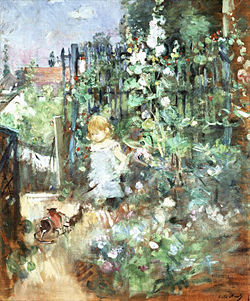
Her works include not only landscapes, portraits, garden settings, and boating scenes, but also subjects portraying the comfort and intimacy of family and domestic life, as did her colleagues, Pierre-Auguste Renoir and Mary Cassatt. Though she was not successful commercially during her life time, she outsold Claude Monet, Pierre-Auguste Renoir, and Alfred Sisley.
Her work includes:
- Un Village, 1895, (Le Village de Maurecourt), pastel.
- Study: At the Water's Edge, 1864. One of her few early paintings.
- Portrait of Edma Pontillion, 1869, (Young Woman Seated at a Window), the artist's sister at a window.
- Marine, 1869, (The Harbor at Larient), oil.
- La Lecture, 1869-70, (Reading: The mother and sister, Edma, of the artist), oil.
- On the Balcony, 1871-1872.
- Le Berceau, 1872, (cradle), oil.
- Cashe-cashe, 1873, (Hide and Seek), the models are Berthe's sister Edma, and Edma's daughter Jeanne.
- Portrait de Mademoiselle MT, 1873, (Young girl with a Parrot), pastel.
- Butterfly Hunt, 1874, Edma and her children.
- In a Park, 1974, (On the Grass), Edma and her children.
- Eugéne Manet on the Isle of Wight, 1875.
- Figure of a woman, 1875-76, (Before the Theater).
- The Pscyhé, 1876, (The Cheval Glass).
- Portrait of Marcel Gobillard, 1880, (Little Boy in Gray), the artist's nephew.
- Peasant Hanging out the Washing, 1881, oil.
- Little Girl with a Doll, 1884.
- The Bath, 1885-86,(Girl Arranging Her Hair), the model is Isabelle Lambert.
- Little Girl Reading, 1888, the model is Jeanne Bonnet.
- Juliet Manet et son Levrier Laerte, 1893.
- Juliet Reveuse, 1894, (Julie Daydreaming), the model is her daughter.
Berthe Morisot died aged 54, on March 2, 1895 in Paris and was interred in the Cimetière de Passy.
Gallery
- Berthe Morisot 007.jpg
See also
- Women artists
ReferencesISBN links support NWE through referral fees
- Denvir, B., The Chronicle of Impressionism: An Intimate Diary of the Lives and World of the Great Artists. London: Thames & Hudson, 2000. ISBN 978-0500282144
- Turner, J. (2000). From Monet to Cézanne: late 19th-century French artists. Grove Art. New York: St Martin's Press. ISBN 0-312-22971-2
- Adler, Kathleen, Berthe Morisot. Phaidon Press; Reprint edition, 1995. ISBN 978-0714834795
- Higonnet, Anne, Berthe Morisot. University of California Press; New Ed edition, 1995. ISBN 978-0520201569
- Encyclopedia Britannica online, britannica.com. Retrieved April 7, 2007.
External links
- Berthe Morisot at the WebMuseum
Credits
New World Encyclopedia writers and editors rewrote and completed the Wikipedia article in accordance with New World Encyclopedia standards. This article abides by terms of the Creative Commons CC-by-sa 3.0 License (CC-by-sa), which may be used and disseminated with proper attribution. Credit is due under the terms of this license that can reference both the New World Encyclopedia contributors and the selfless volunteer contributors of the Wikimedia Foundation. To cite this article click here for a list of acceptable citing formats.The history of earlier contributions by wikipedians is accessible to researchers here:
The history of this article since it was imported to New World Encyclopedia:
Note: Some restrictions may apply to use of individual images which are separately licensed.
